Report on Management Structure and Business Functions Analysis
VerifiedAdded on 2023/06/15
|10
|1955
|337
Report
AI Summary
This report provides an overview of management structure and business functions within an organization, highlighting their importance and interrelation. It discusses various organizational structures, including hierarchical, functional, and divisional, along with their advantages and disadvantages. The report also examines key business functions such as marketing, finance, and human resources, detailing their roles and connections. Furthermore, it explores management functions like planning, organizing, staffing, and controlling, emphasizing their interconnectedness. The significance of HR and talent management in employee well-being and the impact of organizational culture on company standards are also discussed. The report concludes that effective management and well-coordinated business functions are crucial for organizational success. Desklib provides access to similar solved assignments and study resources for students.
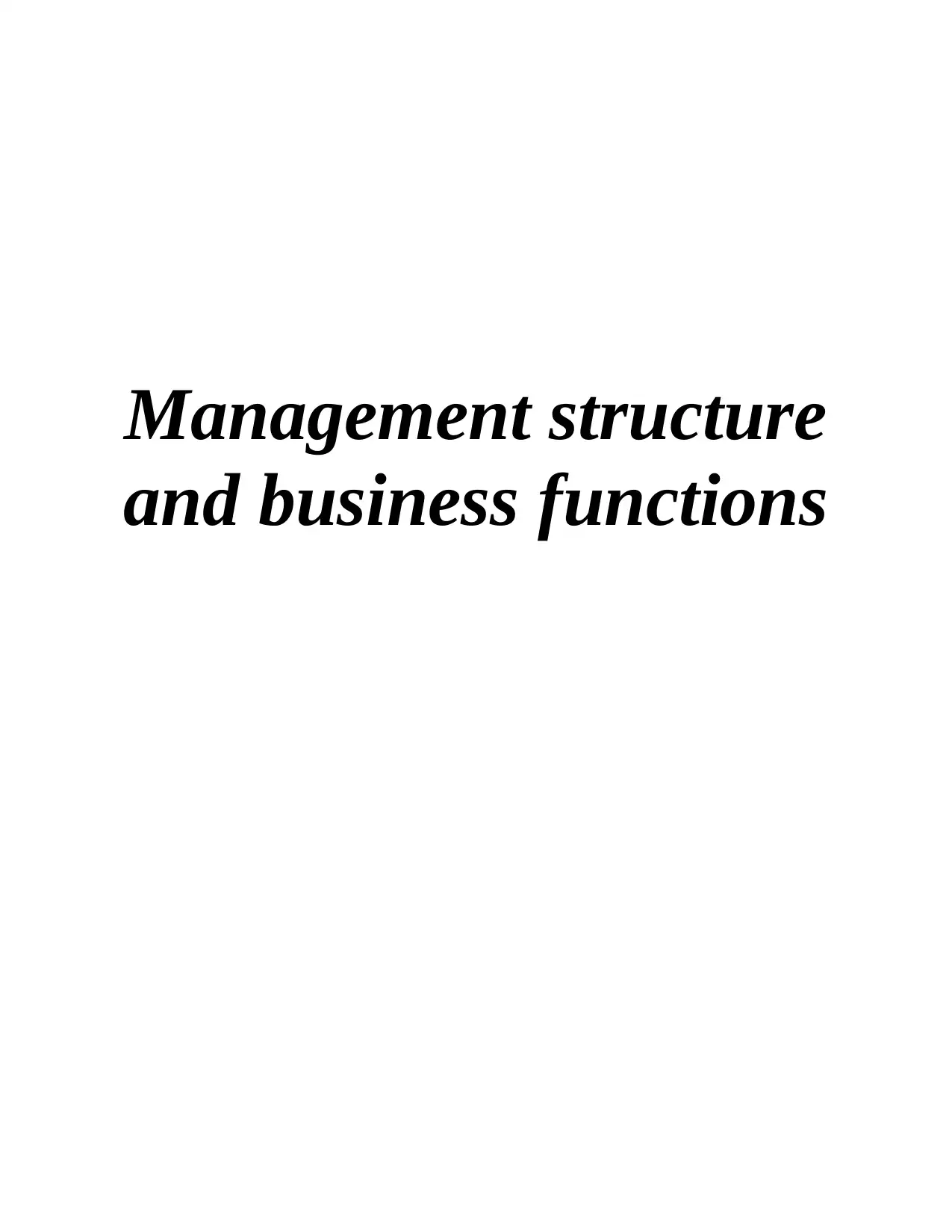
Management structure
and business functions
and business functions
Paraphrase This Document
Need a fresh take? Get an instant paraphrase of this document with our AI Paraphraser
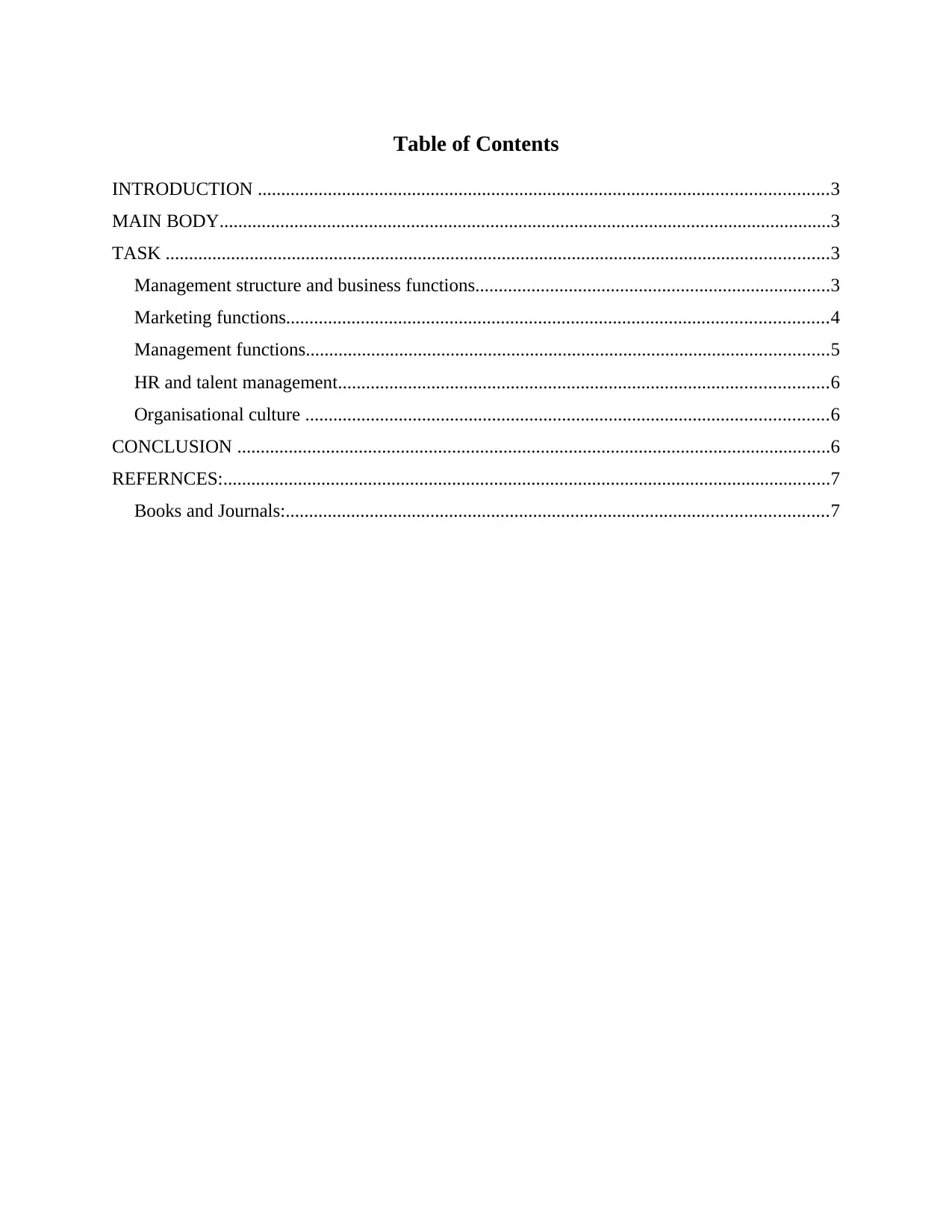
Table of Contents
INTRODUCTION ..........................................................................................................................3
MAIN BODY...................................................................................................................................3
TASK ..............................................................................................................................................3
Management structure and business functions............................................................................3
Marketing functions....................................................................................................................4
Management functions................................................................................................................5
HR and talent management.........................................................................................................6
Organisational culture ................................................................................................................6
CONCLUSION ...............................................................................................................................6
REFERNCES:..................................................................................................................................7
Books and Journals:....................................................................................................................7
INTRODUCTION ..........................................................................................................................3
MAIN BODY...................................................................................................................................3
TASK ..............................................................................................................................................3
Management structure and business functions............................................................................3
Marketing functions....................................................................................................................4
Management functions................................................................................................................5
HR and talent management.........................................................................................................6
Organisational culture ................................................................................................................6
CONCLUSION ...............................................................................................................................6
REFERNCES:..................................................................................................................................7
Books and Journals:....................................................................................................................7
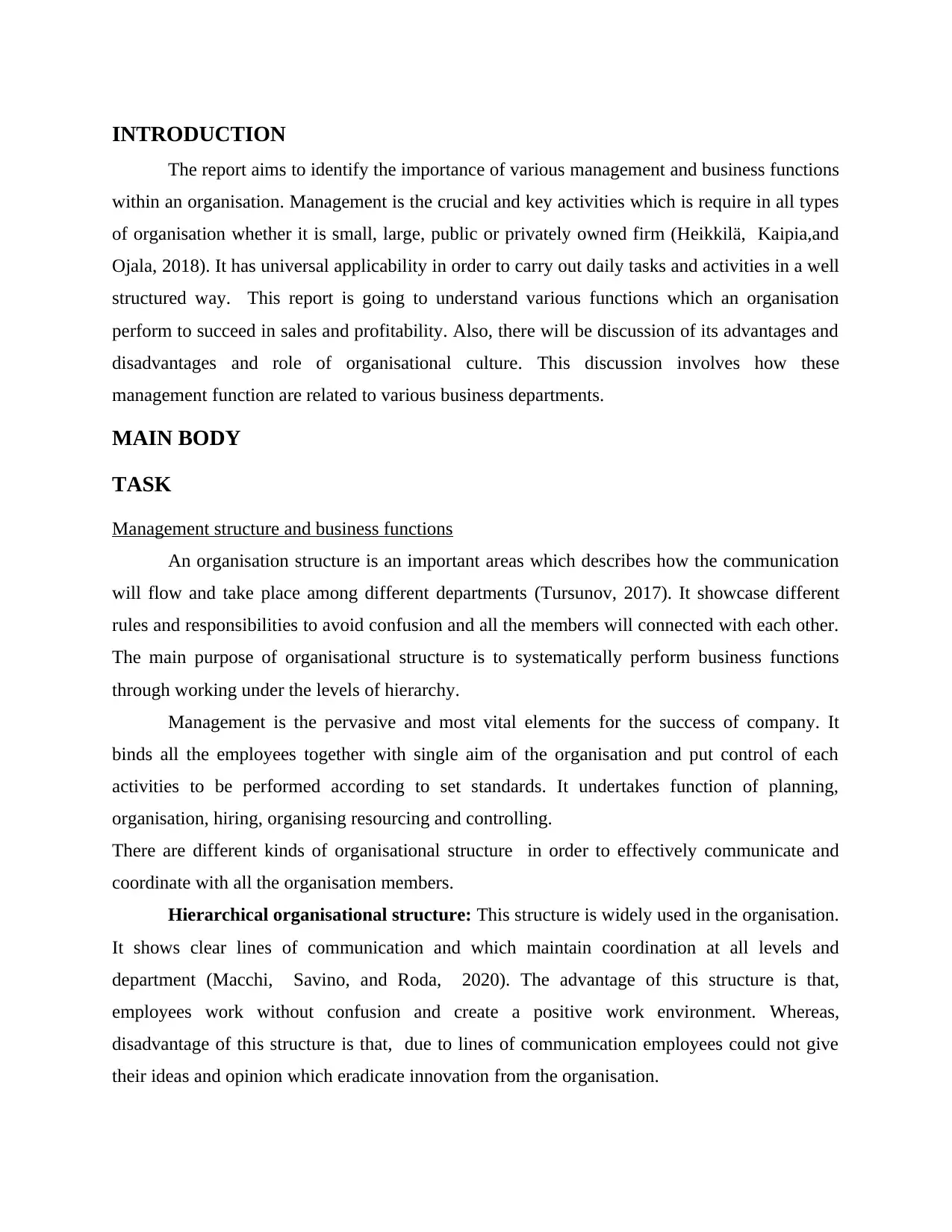
INTRODUCTION
The report aims to identify the importance of various management and business functions
within an organisation. Management is the crucial and key activities which is require in all types
of organisation whether it is small, large, public or privately owned firm (Heikkilä, Kaipia,and
Ojala, 2018). It has universal applicability in order to carry out daily tasks and activities in a well
structured way. This report is going to understand various functions which an organisation
perform to succeed in sales and profitability. Also, there will be discussion of its advantages and
disadvantages and role of organisational culture. This discussion involves how these
management function are related to various business departments.
MAIN BODY
TASK
Management structure and business functions
An organisation structure is an important areas which describes how the communication
will flow and take place among different departments (Tursunov, 2017). It showcase different
rules and responsibilities to avoid confusion and all the members will connected with each other.
The main purpose of organisational structure is to systematically perform business functions
through working under the levels of hierarchy.
Management is the pervasive and most vital elements for the success of company. It
binds all the employees together with single aim of the organisation and put control of each
activities to be performed according to set standards. It undertakes function of planning,
organisation, hiring, organising resourcing and controlling.
There are different kinds of organisational structure in order to effectively communicate and
coordinate with all the organisation members.
Hierarchical organisational structure: This structure is widely used in the organisation.
It shows clear lines of communication and which maintain coordination at all levels and
department (Macchi, Savino, and Roda, 2020). The advantage of this structure is that,
employees work without confusion and create a positive work environment. Whereas,
disadvantage of this structure is that, due to lines of communication employees could not give
their ideas and opinion which eradicate innovation from the organisation.
The report aims to identify the importance of various management and business functions
within an organisation. Management is the crucial and key activities which is require in all types
of organisation whether it is small, large, public or privately owned firm (Heikkilä, Kaipia,and
Ojala, 2018). It has universal applicability in order to carry out daily tasks and activities in a well
structured way. This report is going to understand various functions which an organisation
perform to succeed in sales and profitability. Also, there will be discussion of its advantages and
disadvantages and role of organisational culture. This discussion involves how these
management function are related to various business departments.
MAIN BODY
TASK
Management structure and business functions
An organisation structure is an important areas which describes how the communication
will flow and take place among different departments (Tursunov, 2017). It showcase different
rules and responsibilities to avoid confusion and all the members will connected with each other.
The main purpose of organisational structure is to systematically perform business functions
through working under the levels of hierarchy.
Management is the pervasive and most vital elements for the success of company. It
binds all the employees together with single aim of the organisation and put control of each
activities to be performed according to set standards. It undertakes function of planning,
organisation, hiring, organising resourcing and controlling.
There are different kinds of organisational structure in order to effectively communicate and
coordinate with all the organisation members.
Hierarchical organisational structure: This structure is widely used in the organisation.
It shows clear lines of communication and which maintain coordination at all levels and
department (Macchi, Savino, and Roda, 2020). The advantage of this structure is that,
employees work without confusion and create a positive work environment. Whereas,
disadvantage of this structure is that, due to lines of communication employees could not give
their ideas and opinion which eradicate innovation from the organisation.
⊘ This is a preview!⊘
Do you want full access?
Subscribe today to unlock all pages.

Trusted by 1+ million students worldwide
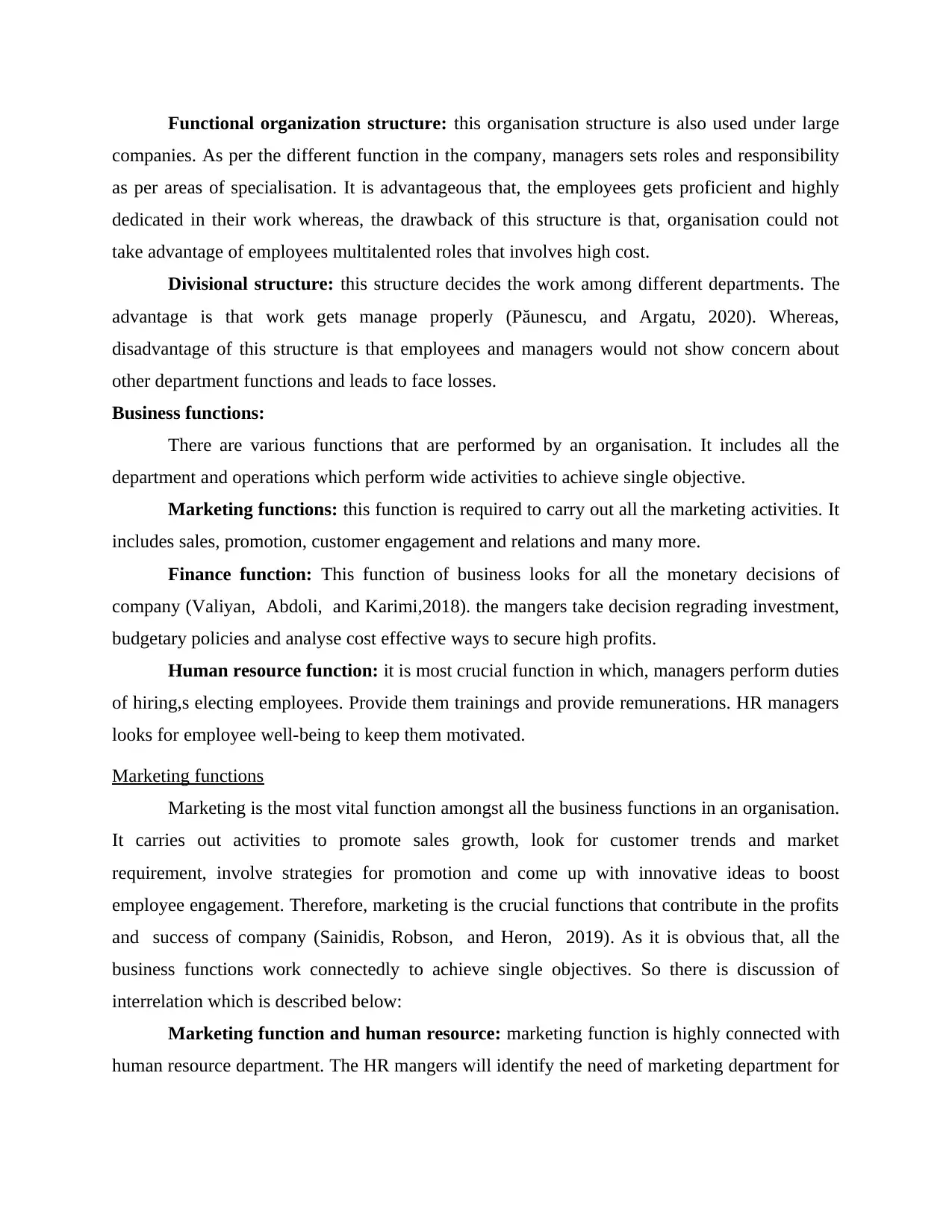
Functional organization structure: this organisation structure is also used under large
companies. As per the different function in the company, managers sets roles and responsibility
as per areas of specialisation. It is advantageous that, the employees gets proficient and highly
dedicated in their work whereas, the drawback of this structure is that, organisation could not
take advantage of employees multitalented roles that involves high cost.
Divisional structure: this structure decides the work among different departments. The
advantage is that work gets manage properly (Păunescu, and Argatu, 2020). Whereas,
disadvantage of this structure is that employees and managers would not show concern about
other department functions and leads to face losses.
Business functions:
There are various functions that are performed by an organisation. It includes all the
department and operations which perform wide activities to achieve single objective.
Marketing functions: this function is required to carry out all the marketing activities. It
includes sales, promotion, customer engagement and relations and many more.
Finance function: This function of business looks for all the monetary decisions of
company (Valiyan, Abdoli, and Karimi,2018). the mangers take decision regrading investment,
budgetary policies and analyse cost effective ways to secure high profits.
Human resource function: it is most crucial function in which, managers perform duties
of hiring,s electing employees. Provide them trainings and provide remunerations. HR managers
looks for employee well-being to keep them motivated.
Marketing functions
Marketing is the most vital function amongst all the business functions in an organisation.
It carries out activities to promote sales growth, look for customer trends and market
requirement, involve strategies for promotion and come up with innovative ideas to boost
employee engagement. Therefore, marketing is the crucial functions that contribute in the profits
and success of company (Sainidis, Robson, and Heron, 2019). As it is obvious that, all the
business functions work connectedly to achieve single objectives. So there is discussion of
interrelation which is described below:
Marketing function and human resource: marketing function is highly connected with
human resource department. The HR mangers will identify the need of marketing department for
companies. As per the different function in the company, managers sets roles and responsibility
as per areas of specialisation. It is advantageous that, the employees gets proficient and highly
dedicated in their work whereas, the drawback of this structure is that, organisation could not
take advantage of employees multitalented roles that involves high cost.
Divisional structure: this structure decides the work among different departments. The
advantage is that work gets manage properly (Păunescu, and Argatu, 2020). Whereas,
disadvantage of this structure is that employees and managers would not show concern about
other department functions and leads to face losses.
Business functions:
There are various functions that are performed by an organisation. It includes all the
department and operations which perform wide activities to achieve single objective.
Marketing functions: this function is required to carry out all the marketing activities. It
includes sales, promotion, customer engagement and relations and many more.
Finance function: This function of business looks for all the monetary decisions of
company (Valiyan, Abdoli, and Karimi,2018). the mangers take decision regrading investment,
budgetary policies and analyse cost effective ways to secure high profits.
Human resource function: it is most crucial function in which, managers perform duties
of hiring,s electing employees. Provide them trainings and provide remunerations. HR managers
looks for employee well-being to keep them motivated.
Marketing functions
Marketing is the most vital function amongst all the business functions in an organisation.
It carries out activities to promote sales growth, look for customer trends and market
requirement, involve strategies for promotion and come up with innovative ideas to boost
employee engagement. Therefore, marketing is the crucial functions that contribute in the profits
and success of company (Sainidis, Robson, and Heron, 2019). As it is obvious that, all the
business functions work connectedly to achieve single objectives. So there is discussion of
interrelation which is described below:
Marketing function and human resource: marketing function is highly connected with
human resource department. The HR mangers will identify the need of marketing department for
Paraphrase This Document
Need a fresh take? Get an instant paraphrase of this document with our AI Paraphraser
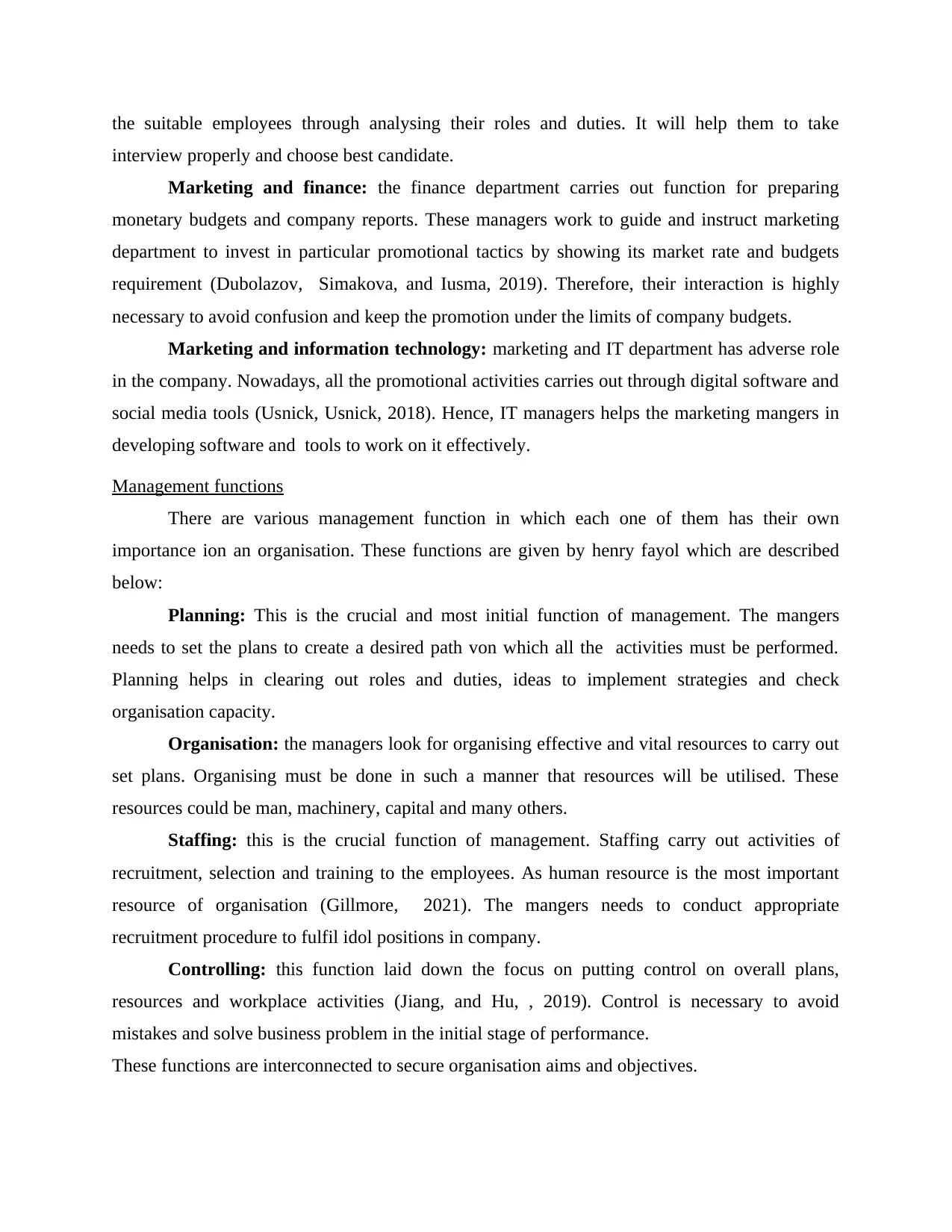
the suitable employees through analysing their roles and duties. It will help them to take
interview properly and choose best candidate.
Marketing and finance: the finance department carries out function for preparing
monetary budgets and company reports. These managers work to guide and instruct marketing
department to invest in particular promotional tactics by showing its market rate and budgets
requirement (Dubolazov, Simakova, and Iusma, 2019). Therefore, their interaction is highly
necessary to avoid confusion and keep the promotion under the limits of company budgets.
Marketing and information technology: marketing and IT department has adverse role
in the company. Nowadays, all the promotional activities carries out through digital software and
social media tools (Usnick, Usnick, 2018). Hence, IT managers helps the marketing mangers in
developing software and tools to work on it effectively.
Management functions
There are various management function in which each one of them has their own
importance ion an organisation. These functions are given by henry fayol which are described
below:
Planning: This is the crucial and most initial function of management. The mangers
needs to set the plans to create a desired path von which all the activities must be performed.
Planning helps in clearing out roles and duties, ideas to implement strategies and check
organisation capacity.
Organisation: the managers look for organising effective and vital resources to carry out
set plans. Organising must be done in such a manner that resources will be utilised. These
resources could be man, machinery, capital and many others.
Staffing: this is the crucial function of management. Staffing carry out activities of
recruitment, selection and training to the employees. As human resource is the most important
resource of organisation (Gillmore, 2021). The mangers needs to conduct appropriate
recruitment procedure to fulfil idol positions in company.
Controlling: this function laid down the focus on putting control on overall plans,
resources and workplace activities (Jiang, and Hu, , 2019). Control is necessary to avoid
mistakes and solve business problem in the initial stage of performance.
These functions are interconnected to secure organisation aims and objectives.
interview properly and choose best candidate.
Marketing and finance: the finance department carries out function for preparing
monetary budgets and company reports. These managers work to guide and instruct marketing
department to invest in particular promotional tactics by showing its market rate and budgets
requirement (Dubolazov, Simakova, and Iusma, 2019). Therefore, their interaction is highly
necessary to avoid confusion and keep the promotion under the limits of company budgets.
Marketing and information technology: marketing and IT department has adverse role
in the company. Nowadays, all the promotional activities carries out through digital software and
social media tools (Usnick, Usnick, 2018). Hence, IT managers helps the marketing mangers in
developing software and tools to work on it effectively.
Management functions
There are various management function in which each one of them has their own
importance ion an organisation. These functions are given by henry fayol which are described
below:
Planning: This is the crucial and most initial function of management. The mangers
needs to set the plans to create a desired path von which all the activities must be performed.
Planning helps in clearing out roles and duties, ideas to implement strategies and check
organisation capacity.
Organisation: the managers look for organising effective and vital resources to carry out
set plans. Organising must be done in such a manner that resources will be utilised. These
resources could be man, machinery, capital and many others.
Staffing: this is the crucial function of management. Staffing carry out activities of
recruitment, selection and training to the employees. As human resource is the most important
resource of organisation (Gillmore, 2021). The mangers needs to conduct appropriate
recruitment procedure to fulfil idol positions in company.
Controlling: this function laid down the focus on putting control on overall plans,
resources and workplace activities (Jiang, and Hu, , 2019). Control is necessary to avoid
mistakes and solve business problem in the initial stage of performance.
These functions are interconnected to secure organisation aims and objectives.
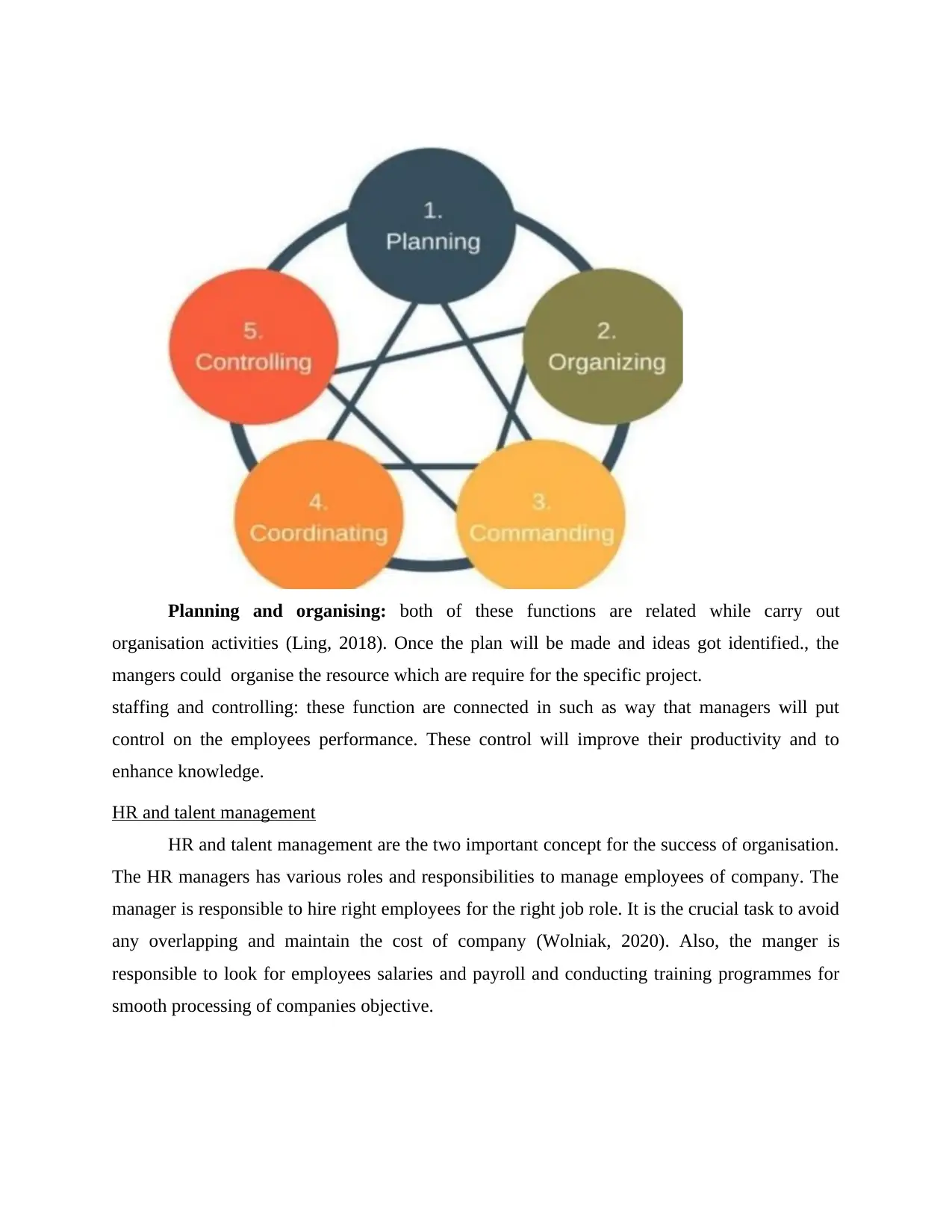
Planning and organising: both of these functions are related while carry out
organisation activities (Ling, 2018). Once the plan will be made and ideas got identified., the
mangers could organise the resource which are require for the specific project.
staffing and controlling: these function are connected in such as way that managers will put
control on the employees performance. These control will improve their productivity and to
enhance knowledge.
HR and talent management
HR and talent management are the two important concept for the success of organisation.
The HR managers has various roles and responsibilities to manage employees of company. The
manager is responsible to hire right employees for the right job role. It is the crucial task to avoid
any overlapping and maintain the cost of company (Wolniak, 2020). Also, the manger is
responsible to look for employees salaries and payroll and conducting training programmes for
smooth processing of companies objective.
organisation activities (Ling, 2018). Once the plan will be made and ideas got identified., the
mangers could organise the resource which are require for the specific project.
staffing and controlling: these function are connected in such as way that managers will put
control on the employees performance. These control will improve their productivity and to
enhance knowledge.
HR and talent management
HR and talent management are the two important concept for the success of organisation.
The HR managers has various roles and responsibilities to manage employees of company. The
manager is responsible to hire right employees for the right job role. It is the crucial task to avoid
any overlapping and maintain the cost of company (Wolniak, 2020). Also, the manger is
responsible to look for employees salaries and payroll and conducting training programmes for
smooth processing of companies objective.
⊘ This is a preview!⊘
Do you want full access?
Subscribe today to unlock all pages.

Trusted by 1+ million students worldwide
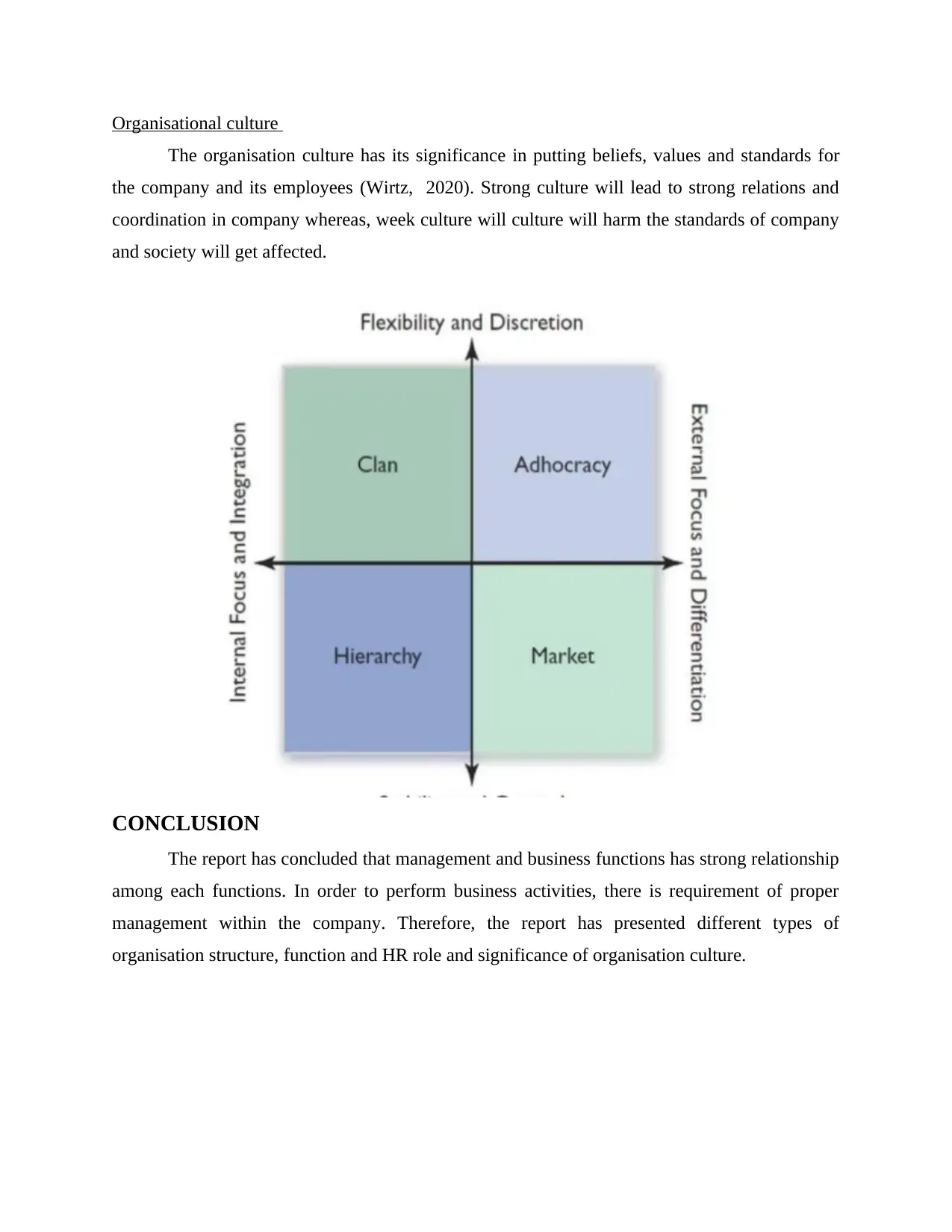
Organisational culture
The organisation culture has its significance in putting beliefs, values and standards for
the company and its employees (Wirtz, 2020). Strong culture will lead to strong relations and
coordination in company whereas, week culture will culture will harm the standards of company
and society will get affected.
CONCLUSION
The report has concluded that management and business functions has strong relationship
among each functions. In order to perform business activities, there is requirement of proper
management within the company. Therefore, the report has presented different types of
organisation structure, function and HR role and significance of organisation culture.
The organisation culture has its significance in putting beliefs, values and standards for
the company and its employees (Wirtz, 2020). Strong culture will lead to strong relations and
coordination in company whereas, week culture will culture will harm the standards of company
and society will get affected.
CONCLUSION
The report has concluded that management and business functions has strong relationship
among each functions. In order to perform business activities, there is requirement of proper
management within the company. Therefore, the report has presented different types of
organisation structure, function and HR role and significance of organisation culture.
Paraphrase This Document
Need a fresh take? Get an instant paraphrase of this document with our AI Paraphraser

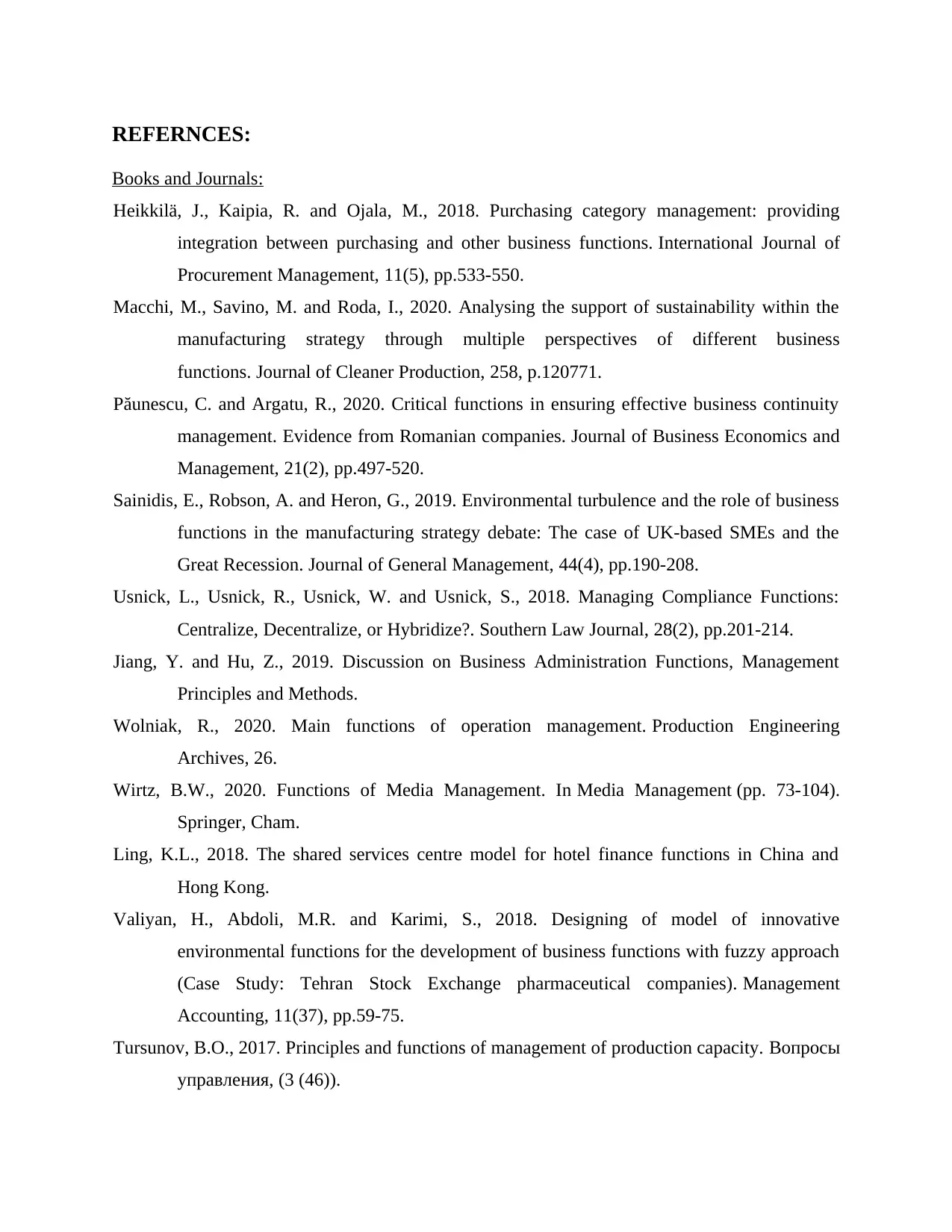
REFERNCES:
Books and Journals:
Heikkilä, J., Kaipia, R. and Ojala, M., 2018. Purchasing category management: providing
integration between purchasing and other business functions. International Journal of
Procurement Management, 11(5), pp.533-550.
Macchi, M., Savino, M. and Roda, I., 2020. Analysing the support of sustainability within the
manufacturing strategy through multiple perspectives of different business
functions. Journal of Cleaner Production, 258, p.120771.
Păunescu, C. and Argatu, R., 2020. Critical functions in ensuring effective business continuity
management. Evidence from Romanian companies. Journal of Business Economics and
Management, 21(2), pp.497-520.
Sainidis, E., Robson, A. and Heron, G., 2019. Environmental turbulence and the role of business
functions in the manufacturing strategy debate: The case of UK-based SMEs and the
Great Recession. Journal of General Management, 44(4), pp.190-208.
Usnick, L., Usnick, R., Usnick, W. and Usnick, S., 2018. Managing Compliance Functions:
Centralize, Decentralize, or Hybridize?. Southern Law Journal, 28(2), pp.201-214.
Jiang, Y. and Hu, Z., 2019. Discussion on Business Administration Functions, Management
Principles and Methods.
Wolniak, R., 2020. Main functions of operation management. Production Engineering
Archives, 26.
Wirtz, B.W., 2020. Functions of Media Management. In Media Management (pp. 73-104).
Springer, Cham.
Ling, K.L., 2018. The shared services centre model for hotel finance functions in China and
Hong Kong.
Valiyan, H., Abdoli, M.R. and Karimi, S., 2018. Designing of model of innovative
environmental functions for the development of business functions with fuzzy approach
(Case Study: Tehran Stock Exchange pharmaceutical companies). Management
Accounting, 11(37), pp.59-75.
Tursunov, B.O., 2017. Principles and functions of management of production capacity. Вопросы
управления, (3 (46)).
Books and Journals:
Heikkilä, J., Kaipia, R. and Ojala, M., 2018. Purchasing category management: providing
integration between purchasing and other business functions. International Journal of
Procurement Management, 11(5), pp.533-550.
Macchi, M., Savino, M. and Roda, I., 2020. Analysing the support of sustainability within the
manufacturing strategy through multiple perspectives of different business
functions. Journal of Cleaner Production, 258, p.120771.
Păunescu, C. and Argatu, R., 2020. Critical functions in ensuring effective business continuity
management. Evidence from Romanian companies. Journal of Business Economics and
Management, 21(2), pp.497-520.
Sainidis, E., Robson, A. and Heron, G., 2019. Environmental turbulence and the role of business
functions in the manufacturing strategy debate: The case of UK-based SMEs and the
Great Recession. Journal of General Management, 44(4), pp.190-208.
Usnick, L., Usnick, R., Usnick, W. and Usnick, S., 2018. Managing Compliance Functions:
Centralize, Decentralize, or Hybridize?. Southern Law Journal, 28(2), pp.201-214.
Jiang, Y. and Hu, Z., 2019. Discussion on Business Administration Functions, Management
Principles and Methods.
Wolniak, R., 2020. Main functions of operation management. Production Engineering
Archives, 26.
Wirtz, B.W., 2020. Functions of Media Management. In Media Management (pp. 73-104).
Springer, Cham.
Ling, K.L., 2018. The shared services centre model for hotel finance functions in China and
Hong Kong.
Valiyan, H., Abdoli, M.R. and Karimi, S., 2018. Designing of model of innovative
environmental functions for the development of business functions with fuzzy approach
(Case Study: Tehran Stock Exchange pharmaceutical companies). Management
Accounting, 11(37), pp.59-75.
Tursunov, B.O., 2017. Principles and functions of management of production capacity. Вопросы
управления, (3 (46)).
⊘ This is a preview!⊘
Do you want full access?
Subscribe today to unlock all pages.

Trusted by 1+ million students worldwide
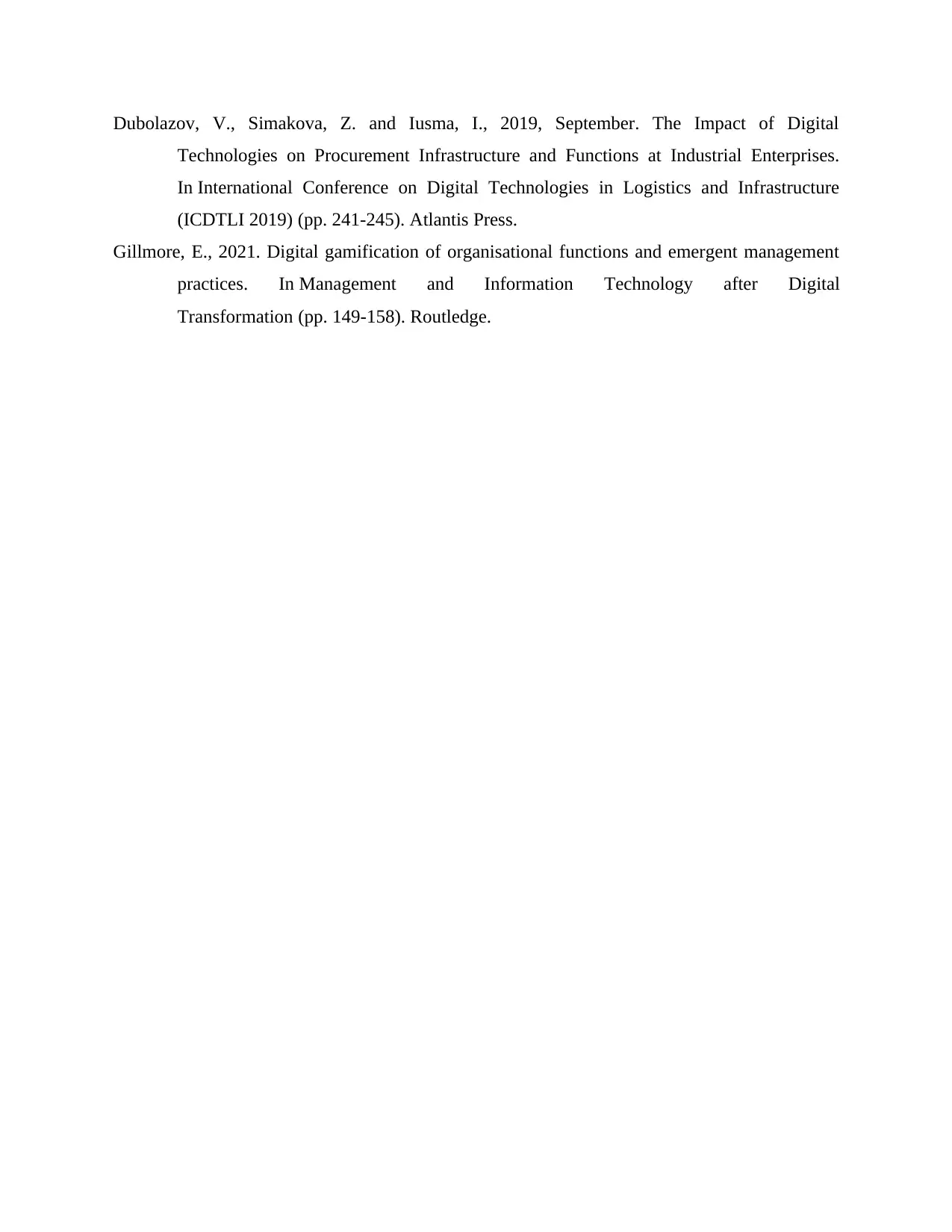
Dubolazov, V., Simakova, Z. and Iusma, I., 2019, September. The Impact of Digital
Technologies on Procurement Infrastructure and Functions at Industrial Enterprises.
In International Conference on Digital Technologies in Logistics and Infrastructure
(ICDTLI 2019) (pp. 241-245). Atlantis Press.
Gillmore, E., 2021. Digital gamification of organisational functions and emergent management
practices. In Management and Information Technology after Digital
Transformation (pp. 149-158). Routledge.
Technologies on Procurement Infrastructure and Functions at Industrial Enterprises.
In International Conference on Digital Technologies in Logistics and Infrastructure
(ICDTLI 2019) (pp. 241-245). Atlantis Press.
Gillmore, E., 2021. Digital gamification of organisational functions and emergent management
practices. In Management and Information Technology after Digital
Transformation (pp. 149-158). Routledge.
1 out of 10
Related Documents
Your All-in-One AI-Powered Toolkit for Academic Success.
+13062052269
info@desklib.com
Available 24*7 on WhatsApp / Email
![[object Object]](/_next/static/media/star-bottom.7253800d.svg)
Unlock your academic potential
Copyright © 2020–2025 A2Z Services. All Rights Reserved. Developed and managed by ZUCOL.



